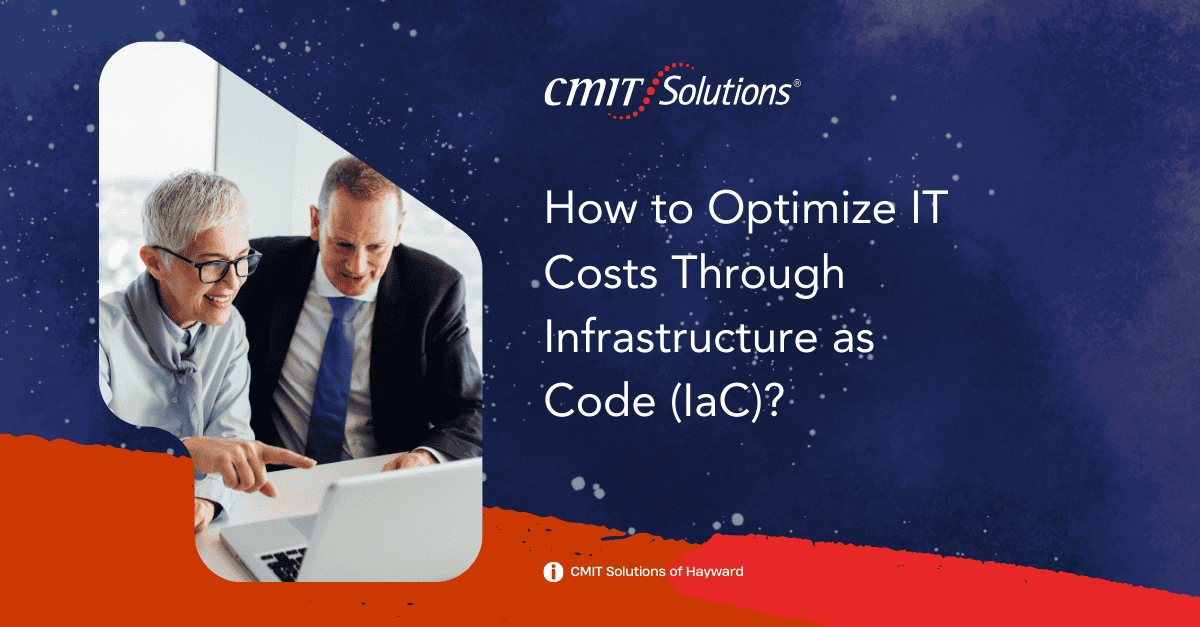As businesses increasingly rely on IT infrastructure to deliver services, manage operations, and scale efficiently, the need for cost-effective IT management strategies has grown significantly. One transformative approach to achieving this is adopting Infrastructure as Code (IaC). IaC automates the deployment and management of IT infrastructure using code, offering significant cost-saving opportunities for businesses of all sizes.
In this blog, we’ll explore what Infrastructure as Code is, how it works, and how it can help optimize IT costs. We’ll also discuss how CMIT Solutions of Hayward can help your business harness the power of IaC for efficiency and growth.
What Is Infrastructure as Code (IaC)?
Infrastructure as Code (IaC) is a practice that uses code to provision, configure, and manage IT infrastructure. Instead of manually setting up servers, networks, and storage, businesses use scripts or configuration files to automate the process. These configurations are reusable and version-controlled, much like application code.
Popular IaC tools include:
- Terraform
- AWS Cloud Formation
- Ansible
- Chef
- Puppet
With IaC, businesses can deploy infrastructure consistently, scale operations efficiently, and reduce the potential for human errors.
How Does IaC Work?
IaC operates on the principle of automation and versioning. Here’s how it works:
- Define Infrastructure in Code: IT teams write configuration files that describe the desired state of the infrastructure.
- Provision Infrastructure: IaC tools read the configuration files and provision the required resources (e.g., servers, databases, and networks) automatically.
- Manage and Update: When infrastructure changes are needed, updates are made to the configuration file and applied seamlessly.
IaC allows businesses to treat infrastructure configurations as code, making deployment faster, more predictable, and easier to manage.
Benefits of IaC for IT Cost Optimization
1. Reduces Manual Labor Costs
Manually provisioning and configuring infrastructure is time-consuming and labor-intensive. IaC automates these tasks, freeing up your IT team to focus on strategic initiatives. Learn more about our IT support services.
2. Eliminates Overprovisioning
IaC makes it easier to scale resources dynamically, ensuring that your business only pays for what it uses. This helps reduce costs associated with overprovisioning servers or storage. Our cloud services are designed to maximize efficiency.
3. Improves Resource Utilization
By automating infrastructure deployment, IaC ensures that resources are used optimally, minimizing waste and reducing costs.
4. Minimizes Downtime
IaC configurations are consistent and repeatable, reducing the likelihood of errors that can lead to downtime. This ensures smoother operations and fewer costs associated with disruptions.
5. Simplifies Scaling
As your business grows, IaC makes it easy to scale infrastructure up or down without significant manual intervention. Our IT guidance helps businesses scale confidently.
6. Streamlines Compliance
With IaC, compliance configurations can be codified, ensuring that all infrastructure adheres to regulatory requirements. This reduces the risk of fines or penalties due to non-compliance. Learn more about our compliance solutions.
7. Enables DevOps Practices
IaC aligns with DevOps methodologies, enabling faster deployment cycles and reducing costs associated with long development and testing phases.
How to Implement IaC for Cost Optimization
1. Assess Your Current IT Infrastructure
Evaluate your existing IT environment to identify areas where IaC can provide the most value. Consider resources like servers, storage, networking, and cloud services.
2. Choose the Right IaC Tool
Select an IaC tool that aligns with your business needs and infrastructure. Tools like Terraform or AWS Cloud Formation are ideal for cloud environments, while Ansible or Puppet may suit hybrid setups.
3. Automate Routine Tasks
Identify repetitive tasks, such as provisioning servers or setting up virtual machines, and automate them with IaC.
4. Leverage Version Control
Store your IaC configuration files in a version control system (e.g., Git). This ensures transparency, tracks changes, and enables collaboration.
5. Optimize Resource Allocation
Use IaC to deploy resources dynamically, ensuring that your infrastructure scales based on actual demand.
6. Monitor and Review
Continuously monitor your infrastructure for performance and cost savings. Adjust IaC configurations as needed to maintain optimal efficiency.
7. Partner with Experts
Implementing IaC can be complex without the right expertise. Partnering with a managed IT provider like CMIT Solutions of Hayward ensures a smooth transition and long-term success. Contact us for expert guidance.
Use Cases for IaC in Small and Medium-Sized Businesses
1. Multi-Cloud Management
IaC simplifies managing resources across multiple cloud platforms, ensuring cost efficiency and consistency.
2. Disaster Recovery
IaC enables rapid recovery by automating the deployment of disaster recovery environments.
3. Development and Testing
With IaC, businesses can quickly set up and tear down development and testing environments, reducing operational costs.
4. Compliance Automation
Codify compliance requirements into your IaC configurations to ensure every deployment meets regulatory standards.
5. Continuous Integration/Continuous Deployment (CI/CD)
IaC integrates with CI/CD pipelines, enabling faster and more reliable application deployments.
Challenges of IaC and How to Overcome Them
While IaC offers significant benefits, there are challenges to consider:
- Learning Curve: Adopting IaC requires expertise and training. Partnering with a managed IT provider can bridge this gap.
- Tool Selection: Choosing the right IaC tool can be overwhelming. An expert IT partner can help identify the best solution for your business.
- Initial Setup Costs: While IaC reduces costs long-term, the initial implementation may require investment in tools and training.
CMIT Solutions of Hayward helps businesses overcome these challenges by providing tailored solutions and expert support. Learn more about our IT services packages.
How CMIT Solutions of Hayward Can Help
At CMIT Solutions of Hayward, we specialize in helping businesses optimize IT costs through innovative solutions like Infrastructure as Code. Our services include:
- Cloud Solutions: Streamline and optimize your cloud infrastructure with automated deployments. Explore our cloud services.
- Managed IT Services: We handle your IT needs so you can focus on growing your business. Discover our managed services.
- IT Guidance: Get expert advice on implementing IaC and other cost-saving IT strategies. Learn more about IT guidance.
- Compliance Solutions: Automate compliance with codified regulations for peace of mind. Explore compliance services.
Conclusion
Infrastructure as Code is revolutionizing IT management by automating infrastructure deployment, improving efficiency, and reducing costs. For small and medium-sized businesses, adopting IaC can provide a competitive edge, enabling scalability, reliability, and cost savings.
At CMIT Solutions of Hayward, we’re committed to helping businesses harness the power of IaC to optimize IT costs and achieve operational excellence. Ready to transform your IT infrastructure? Contact us today to get started.
For more insights on optimizing IT and staying ahead of the curve, visit our blog. Together, we’ll build a future-ready IT environment for your business!




